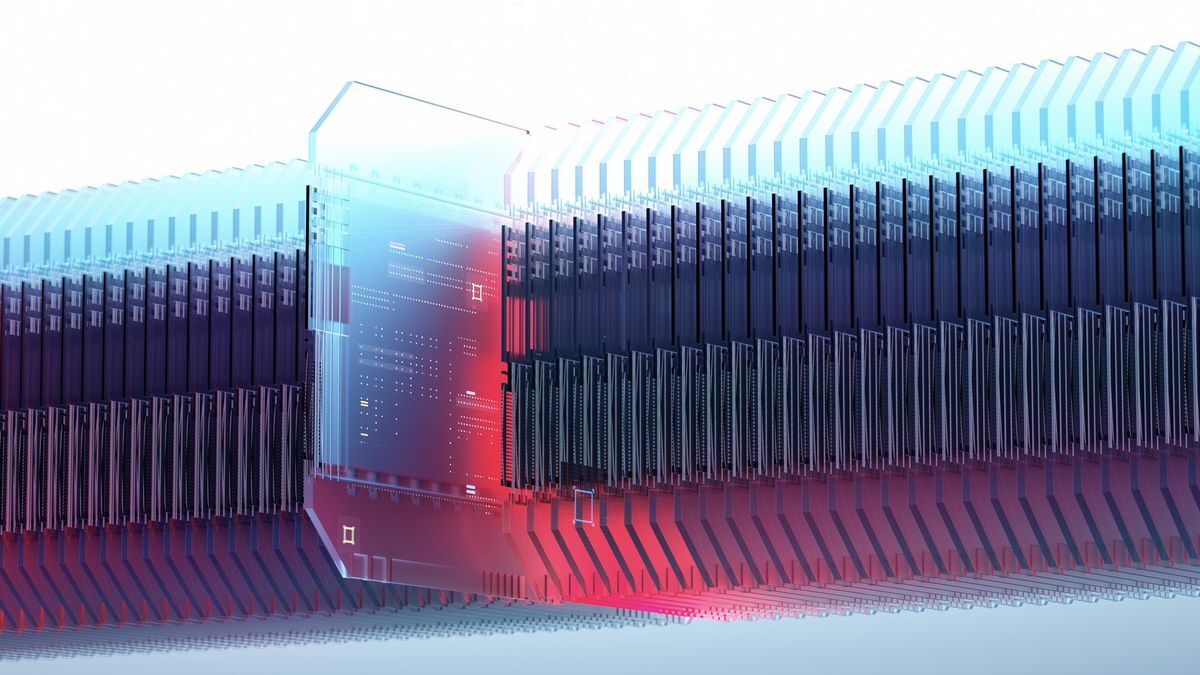- cross-posted to:
- futurology@futurology.today
- technology@lemmy.world
- cross-posted to:
- futurology@futurology.today
- technology@lemmy.world
Those totally look like the isolinear chips from Star Trek
Data is written by two million laser beamlets that punch QR code-like nano-scale patterns into the surface of the media. The laser pulse is sharpened by a digital micromirror device, and shaped by microscope optics onto the surface of the data carrier. This process imprints holes – or no holes – onto the surface layer, which represents binary information.
It’s futuristic punchcards. We’ve come full circle.
It’s futuristic punchcards.
always was.
Pretty much, yeah! CDs and blu-rays aren’t all that different from punch cards, as the data is literally stored as indentations on the disc with a reflective layer. Arguably CD-RWs are kind of different as they change the reflectivity of a material itself… Hard drives and floppies are maaaaybe slightly different too because they use changes in magnetism instead of physical indentations too. You could probably argue that flash and DRAM aren’t glorified punchcards? But I mean, ultimately all data is stored in a physical medium somehow so it’s always going to have some resemblance!
Tapes and spinning disks were futuristic magnetized wire.
Or even eched tablets, we’ve double backed on the full circle.
“Alright class, pull out your chisel and slate…”
Sounds like it would be difficult to rewrite/edit the data?
A punchcard is two dimensional. Actually you can have multiple dimensions on a punch card, the positions of the card can store different data and you can determine what that is by the position of holes on another part of the card.
Whereas a paper tape, or a magnetic tape is serial and has only one dimension (you can divide the tape into different bands though).
I’ve been seeing news stories like this every couple of years for most of my life, and yet storage technology just continues to plod along at the same pace it always has. Nothing ever comes of it.
Just as you probably never see tape storage, you would never see this storage method either, as it’s not intended for personal use.
However, while you do not see tape storage being used, it’s maybe what the majority of world’s storage uses.
It’s a sensational headline, sure - but I manage a few 200TB single unit servers at work and my cell phone has more than 20x the storage the computer I took to college had, and probably 20x faster.
To claim what you are ignores the significant improvements we’ve seen in the past 2 decades.
Obviously I’m not saying storage technology doesn’t improve. But it’s incremental improvements, not exponential like these stories always claim.
idk, I’ve still got some 512kb floppies somewhere.
Next to me is a 512GB flash drive.
1997 - 2023 is 26 years for a 1,000,000x larger storage device.
So come 2049, that should be at 512PB, they’re forecasting 10PB.I say it sounds reasonable enough.
Same. It’s kind of a shame that folks forgot the word “vaporware” and what it means.
Vaporware is when software devs make claims about how great their yet-to-be-written software will be. Then, they never create it, either out of a lack of skill, time, or funding. Vaporware has, by definition, no proof of concept.
Hardware is a bit harder to call “Vaporware” since presumably they have working prototypes.
Commodore 65.
Intellivision computer.
Commodore SuperPET based on the Zilog Z8000.
- All vapourware.
The Atari 2700.
Vaporware historically includes stuff that never gets released officially, or was cancelled during the development process but was already advertised. One example of this was the Hellraiser game for the NES that would have pushed the capabilities of the console well beyond what it was ordinarily capable of because the cart included a Z80 CPU as a coprocessor. The Action Gamemaster (by Active Enterprises) in 1994. The Amiga Walker in 1996. Apple Interactive, which was a set-top box that ran OS 7, but it never went past the test type stage.
So am I wrong to say this is a stone tablet hard drive? Doesn’t seem like you can overwrite data on it
Yeah, looks like write once. Which, we got a lot of mileage out of CD-Rs, libraries are useful.
I feel like we don’t appreciate the history of data storage enough! It’s kind of wild looking at how different the world was when CD-Rs came out. They could store substantially more data than a typical hard drive of the time and were dirt cheap. So you would get bulletin boards hosting content from optical drives and stuff. It’s also (partially) why you would have to use discs for games in the past, instead of just installing them to the hard drive. When hard drives are expensive it’s probably better to just stream music and assets from an optical disc instead of taking up precious space. Sometimes you could play a game (or part of it) without the disc, but you wouldn’t get music because that was left on the disc.
Sometimes you could even put the game in the CD player and listen to the game tracks!
Oh man, I forgot you could do that. CDs really are cool
They’re still the idea music storage format
I know a few vinyl people looking to fight you. lol
They’d be objectively wrong while arguing their subjective opinion
I would even argue most storage is used as write once storage. From backup systems to libraries, a lot of data is data we want to just record, and never overwrite.
You don’t need to. These are intended for backups and data archiving where storage density matters the most
Seems like thered be some extra hoops to get through for differential backups, impossible to us for most daily applications, probably better suited for things like laboratory and archives…
It looks like you can’t overwrite new data, but you can still punch it full of ones :p
So like CD-Rs but with silica instead of organics.
I like the idea.
Seems more like a standard CD. It can only be written on once.
CD-R is the standard CD. CD-RWs are the rewritable ones.
CD-ROMs are read-only(-memory) & usually stamped plastic covered with mirror-ish surface (aluminum-somethings prob?).
CD-R have an (recordable) organic layer on top you can burn lil patterns into, once only.
CD-RW can be re-written several times.
But none of them really last long.
Many pressed CD-ROMs and audio CDs will likely last over 100 years if stored properly. However, the tolerances in the standard are high so lots of manufacturers use cheaper materials and processes than intended while still producing discs with the CD logo. It will take decades before we really know which were worse than others. The most likely point of failure is delamination, which will leak air between the layers and oxidize the aluminum coating in a process named laser rot after Laserdiscs, the earliest commercial optical disc system.
Anyway, the longetivity of (re)writable CDs is indeed usually below 20 years.
Yes, storage is very important in the long run.
And music industry indeed had some of the thiccest disks afaik.
No, it’s not about the thickness. Most of it is clear plastic anyway, the data layer is only in the top few dozen micrometers. Also, all CDs and later 12cm discs were 1 mm thick by spec.
Yes, I am talking about the top layer - some are def thiccer and more scratch resistant (I didn’t mean thicket like you would notice looking at it from the side).
The recording layers of the CDDAs (1983-1987) had already vanished. So they lasted no longer than 40 years.
"SHM-CD"s would probably meet that 100 year mark but DVDs made them pointless by the time they were first released.
… Data can be written at GBps speeds, with TB/square-centimeter areal densities …
Say, 8 Tbits/cm² (so 1 TB/cm²) …
this is aprox ( 10-7m )2 unit cells.Conventional optical microscopy cannot resolve this, so, maybe they are using evanescent surface optics ?
I like your funny words, magic man
Very happy to hear you saying this, well, this is science not magics :
Evanescent field
https://en.m.wikipedia.org/wiki/Evanescent_field
In electromagnetics, an evanescent field, or evanescent wave, is an oscillating electric and/or magnetic field that does not propagate as an electromagnetic…I like your funny words, magnet man.
Thanks for these kind words Mr C. Happy.
(I know there must be a joke and I’m sorry that I do not get it. I have a lot of difficulty to grasp many jokes. Thanks anyway.)The line “I like your funny words, magic man” is from this scene from Clone High. People use it when they want to show they don’t understand what was said but appreciated it none the less. CrackHappy changed it to “magnet man” because they are least got that much from what you were saying.
Aaah ! that’s why ! Thanks :)
People wouldn’t believe but since 10 years I’ve watched maybe 5 to 10 hours (total) of video including YouTube, TV and whatever. Also went to cinema maybe five times.Missing the odd pop culture reference is understandable in that case haha
🤣
I think it’s 3dimensional not 2
This would absolutely make sense. Unfortunately, they don’t say whether or not (it’s 3D) in the article. Well … they do describe it as a microscopic QR code which is 2D.
Good question. “Everything was built with CoTS components”… Hmm.
deleted by creator
Yes I agree : they must have a very expensive, very powerful and very precise writing device.
Based on the demo video I’m assuming this is more for archival storage rather than on demand. So more like a tape replacement rather than hard drive?
Yes. Hugely important topic in itself. M-Disc is the current best we have, with claims they will last 1000 years if properly stored (limited by the plastic degredation). But ceramics should be more stable, and the speed claims look good. This is not the only tech solution vying to be a long term contender but looks like a potential good one.
That’s the impression I’m getting from it too
Storage tech isn’t as sensationalized and vapor-heavy as battery tech, but I do still wish holographic versatile discs had been a thing.
That thumbnail looks cool
The firm claims it’s cost-effective, fast, and scalable technology for future data storage because no energy is consumed to store data and it can last more than 5,000 years due to the fact it’s made from ceramic. The best hard drives and best SSDs, by contrast, need to be replaced every few years.
lol, they for real discovered something that was discovered 12,000 years ago. ceramic keeps for a long time.
I’m pretty sure their discoveries here are not the material properties of ceramics, but how to turn them into cost effective digital storage devices.
He who keeps the old akindle, and adds new knowledge, is fit to be
a teacheran inventor.
Removed by mod
Removed by mod
Removed by mod













